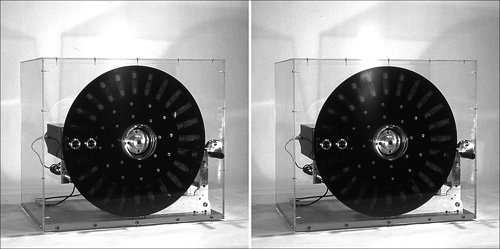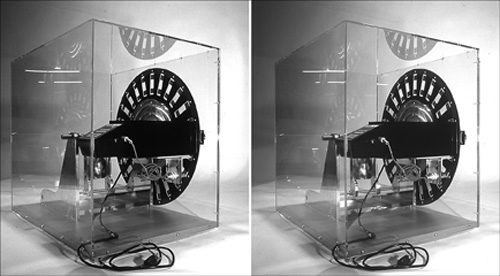| THE STEREOTROPE | ||
|
The Stereotrope is a 3D animation device. It consists of a large disk with 24 pairs of stereo slides. The slides are stop-animation photos of a ball that circles around a hoop. The disk is spun by the visitor via a handle and belt. In close proximity behind the disk is a stroboscope, and below it is a light sensor aimed at 24 little bright dots on the back of the disk. The function of this sensor is to detect when a pair of slides is positioned just in front of the stereoscope and to send a signal to the stroboscope to fire a bright light at that precise moment. The word “Stereotrope” is made up of two words: “STEREOscope” and “zoeTROPE” |
||
 |
The slides were made by photographing the ball at 24 equal positions around the hoop with a stereoscopic camera. The principle of the Stereotrope is the same as the one that allows us to perceive motion pictures. It is called “Persistence of Vision”. Simply put, if we look at an image for a brief period of time, say 1/24th of a second, our brain remembers that image. Thus if we are presented with a succession of still images, our brain remembers the previous image and connects it with the current image to create the illusion of motion. Strictly speaking then, the term “moving pictures” for a movie is not correct, as each individual picture is still and not moving, and only the result is one of perceived motion.
|
|
|
It is very important that the image which flashes briefly in front of our eyes, whether in the cinema or in the Stereotrope is still and not moving. Our brain can connect the succession of still images, but if those are moving, all we would see is a blur. In the cinema, this is achieved by a device that pulls the film in front of light, leaves it there briefly, and then pulls the next frame in front of the light. During movement, the light is obstructed until the next frame is ready for projection. This eliminates a possible blur of the pictures. The Stereotrope achieves the same effect by having the area behind the slides dim in between slides, and brightly lit only when the strobe flashes at the moment the slide is lined up with the stereoscope. Although the disk spins constantly, the brief flash of light from the strobe “freezes” the image for a very brief period of time in front of our eyes to make it a “still image.”
To learn more about 3D animation devices and how to make a 3D flip book go to this page. |
 |
|
 |
||